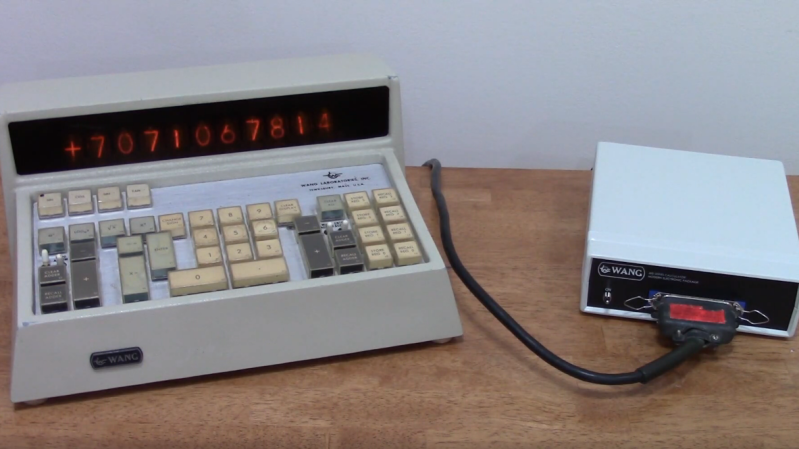With smartphone apps and spreadsheets being the main ways people crunch their numbers nowadays, there’s not much call for a desktop calculator. Or any other physical calculator, for that matter. Which is all the more reason to appreciate this Wang 300-series calculator console’s revival through a new electronic backend.
If you haven’t made the acquaintance of the Wang calculator series, [Bob Alexander]’s previous Wang project is a perfect introduction. Despite looking very much like an overbuilt early-70s desktop calculator, what you see in the video below is just a terminal, one of four that could connect to a shared “Electronics Package” where most of the actual computational work was done. The package was big and is currently hard to come by, at least at a reasonable price, but the consoles, with their Nixie displays and sturdy keypads, are relatively abundant.
[Bob]’s previous venture into reviving his console involved embedding a PIC32-based controller, turning it into the standalone desktop calculator it never was. To keep more with the original design philosophy, [Bob]’s second stab at the problem moves much of the same circuitry from inside the console into a dedicated outboard package, albeit one much smaller than the original. The replacement package extends and enhances the console functionality a bit, adding a real-time clock and a Nixie exercise routine to ward off the dreaded cathode poisoning. [Bob] also recreates the original Wang logarithmic method of multiplication and division, which is a nice touch with its distinctive flashing display.
Seeing the Wang console hooked up to a package through that thick cable and Centronics connector is oddly satisfying. We’d love to see [Bob] take this to the logical extent and support multiple consoles, but that might be pushing things a bit.

















Thanks for the write-up!
I am amazed that a tool such as a desktop calculator was once a server-and-terminal package. A little over 25 years later, I had the same computing power available in a package as big as one of those nixie tubes; namely my wrist watch (we’re talking 1991 here).
I too had one of the wrist watch calculators. Was sort of a ‘geek’ badge at the time :) . No sure what ever happened to it.
Rarely use the calc on phone or a spreadsheet just for calcs. I have the HP-15 sim for on-screen and HP 15C and 16C on my office desk, with a 12C upstairs as a general calculator.
Neat project!
“With smartphone apps and spreadsheets being the main ways people crunch their numbers nowadays, there’s not much call for a desktop calculator.”
Still keep a solar calculator for the same reason people still read on an E-ink reader.
I have not one but two casio fx-82’s (as one is always gone) on my desk: I simple prefer the eye-free blind typing of the rubber keys to having to look at my phone screen (and looking away from where I was looking).
A pocket calculator isn’t exactly a computer, though. It’s more like a stack machine.
Programmable computers and graphical “calculators” are a different story.
Also size and computing speed aren’t everything, so this are apple and orange comparisons.
Things like reliability and accuracy or precision are factors, too.
Super video, and really nice work on putting an old relic to good use. Everyone likes Nixie displays and clacking keys. The date and time display enhances it’s usefulness too.
Absolutely. They’re still wonderful “terminal” devices and as useful as ever.
Having older technology around also is good because of diversity.
Knowing and working with different technologies allows people to extend their horizon and find new solution.
Especially tube technology is a very human-specific technology, I think, because it doesn’t exist in nature.
Using glowing filaments in a vacuum is more ingenious than making crystals “think” (crystal detector, diode, transistor).
Yep, takes us back to days of sitting around the glow of a campfire after a hard day of hunting mastodon!
The compute unit was pretty incredible. To do a square root, it had a sequencer that performed a Newton-Raphson to calculate. Don’t remember how many user stations you could plug into one compute unit. I still have the case for one of the user stations, if anybody wants it. No guts, just the case and bottom plate. Always meant to do something with it.
My very first networked word processor, the WANG…
main problem with the WANG was all the card edge connectors were not gold plated, and oxidized.
Twelve comments so far, and not a single one along the lines of “Wow, that is one big old Wang.”
Very truly yours,
Dick Johnson AKA Biggus Dickus ;-D